The sandbox on the playground is intended for use by children when playing with sand. Usually the object is fenced with bumpers made of wood, but there are structures in the form of houses, land and water transport, flowers. Home craftsmen make a sandbox with their own hands in order to embody an individual idea and bring joy to children.
Types of children's sandboxes for giving
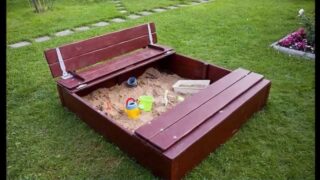
Modern materials are combined to create sophisticated sandboxes to create a strong and durable structure. There are stationary and portable structures, while they are distinguished by the material of the frame.
The boat with sand is of interest to children: it has a steering wheel, a place for the captain's cabin. Other models are equipped with sails that decorate the sandbox, and partially shelter from the sun's rays.
A car loaded with sand is also interesting for children, especially boys. The structure has wheels, steering wheel and benches instead of seats. There are original buildings in the form of flowers, for example, chamomile, cornflower.
By design features
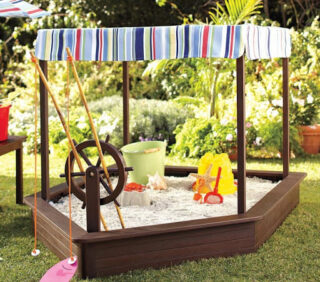
Recessed sandboxes make it so that the base with sand is dug into the ground, and the sides are at ground level. Weeds do not grow in such buildings, insects avoid this place. Raised structures are placed on a turf or concrete base. The sides in height should allow the baby to get inside without help.
A sandbox for children with their own hands can be of different designs:
- prefabricated frame;
- monolithic structure;
- with a canopy;
- open;
- frame with and without a bottom.
Each design has its own advantages. For example, a sandbox with a roof reduces blockages, and bench-shaped sides can be used for children and adults.
In the form of a house
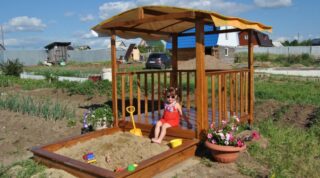
Children love cozy houses in the form of houses, they enjoy spending time there. The style of the building can be different, for example, in the form of a hut, a chalet, a fairytale palace, a rocket - all options will appeal to little sandbox players.
The model protects children from ultraviolet radiation, reduces heat in summer, and protects them from rain. Do-it-yourself children's sandbox made of wood is made most open, windows are provided in it. Benches are placed inside or outside, the roof is also made of natural material, which heats up little by rays.
For the impregnation and coloring of wood, organic preparations are used that do not emit harmful substances into the air that are dangerous for children.
Manufacturing materials
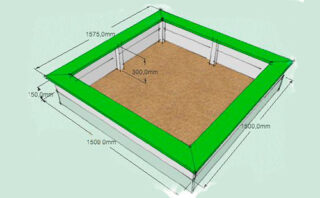
A car, a ship can be made of boards in combination with metal, and colored plastic is suitable for chamomile.
Other materials and items for crafting:
- moisture resistant plywood (OSB);
- logs and barked tree trunks;
- tires from car wheels;
- commodity pallets;
- plastic bottles;
- awnings and nets.
These elements need to be redone, processed in order to be used for construction. Products made from such improvised items have different dimensions and depth. Individual technologies are used for manufacturing.
Usually, plastic containers with sand are bright, compact, convenient objects in the playground for children. Products are not afraid of moisture, they tolerate precipitation without deformation.
Advantages of plastic containers:
- use materials classified as environmentally friendly materials;
- smoothness of the walls, inability to injure hands;
- lightweight construction can be rearranged if necessary on its own.
Products do not work for long in open space conditions. In winter, due to temperature changes, the plastic collapses, and the color fades in the sun. Sandboxes are fragile, so they crack under load.
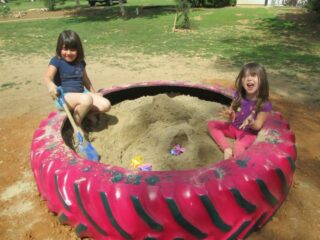
You can make a children's sandbox out of iron, but such products are rarely installed in the yards of apartment buildings, private houses and in summer cottages. This is due to the high heat capacity of the metal, which heats up in the summer heat. It is impossible to touch the walls, so kids are reluctant to play with sand.
The advantages include strength, environmental friendliness of the material.
Metal sides rust from rain, snow, so they are regularly painted to protect them from destruction. Rusty edges can easily injure hands or feet.
You can use copper or aluminum, which are not subject to corrosion, but such a sandbox will be expensive for the owner of the site.
Sandboxes are made of solid wood; pressed panels with wax impregnation (OSB) are also used. The second option is less durable, but it also has a right to exist. Protective impregnations, special paints, varnishes are used to extend the working time of a wooden sandbox.
The advantages include:
- durability with regular care;
- ecological cleanliness;
- low heat capacity (does not heat up in the sun).
Poor sanding of wood parts causes splinters, and delamination of untreated material is also dangerous.
To make a children's sandbox out of pallets with your own hands, you will have to tinker with disassembling containers, assembling parts and processing them. For commercial packaging, unpolished boards are often used, so the unevenness of the fibers on the surface must be smoothed out with an electric tool or hand.
The second stage is the priming of the elements, painting them in several layers, varnishing. Bars are made from pallet boards on a frame with edging, you can also arrange an internal flooring for sand, then cover it with linoleum or film.
Sandbox making instructions

To make a simple model, take bars for the frame with a section of 50 x 50 mm, they are placed at the corners and in the center for strengthening if the sides are long.
Other materials are being prepared:
- planed edged board for side walls with a section of 30 x 200 mm;
- the same lumber on shelves for seating, toys 30 x 150 mm;
- self-tapping screws 45 mm long for wood;
- geotextiles at the bottom of the sandbox;
- antiseptic, wood primer;
- oil or latex paint.
To make a lid, a beam of 50 x 50 mm is harvested, a board of 20 x 150 or waterproof plywood, 4 - 6 pieces of awnings or piano hinges, two handles.
Be sure to make a drawing with the dimensions of the sandbox in order to properly cut the parts and not make mistakes when cutting. More often they take a rectangular version as a basis, the side is mounted from a single board of the required width. This is usually 200 or 150 mm.
The structure can contain chairs, benches, tables on the side or in the center, they are indicated in the project with dimensions. It is better to saw boards in place, do not prepare all the parts at once. Elements require grinding, you can immediately purchase prepared boards at sawn timber sales points.
Site preparation
On the construction site, stones are removed, large tree roots are dug. At the installation site, a fertile layer of earth is removed to a height of 20 cm, it is used for arranging lawns. Determine the place of temporary storage of boards, bars. They are not placed directly on the ground; laths are used so that the material does not come into contact with the soil.
If construction is carried out in a multi-apartment sector, they enclose the place of work with assembly tape. Power tools will be used, so you need to watch so that there are no children nearby.
Where to place the building
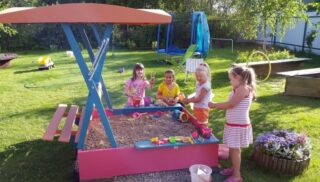
The sandbox should be open to the east and west. In hot climates, the south side of the building is closed to protect children from the scorching rays. In cold regions, the building is blocked from the north side, preventing fresh wind currents, and the southern part is left open.
It is better to build a sandbox in a place where there is no vegetation in order to avoid a large amount of foliage in the sand in the fall. They put the place of the games so that you can see it from the windows of the house or from the entrance. The best place is considered to be in the center of the playground, where there are no swings, rocking chairs and other attractions.
Ideally, if the sandbox is far from the road, where cars are passing, there are exhaust of gasoline and other harmful substances. But this already depends on the location of the entire site.
Markup
The corners of the pit are marked with pegs. They are made of wood or pieces of reinforcement are used. The peg is about 50 cm long, half of which is driven into the soil. Wooden stakes are sharpened at the end to make it easier to drive in if the soil is dense.
A strong cord is pulled between them, it is better to take one that does not stretch, does not sag. Nylon or synthetic rope will do.
Preparation of the base
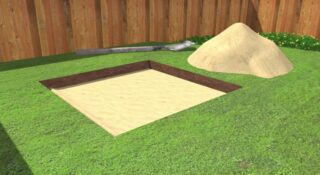
Dig a pit to the depth of the height of the sandbox plus the thickness of the drainage bedding, if the model is being dug. For surface sandboxes, they are deepened only to the height of the pillow.
The drainage base is made with a layer of sand and gravel, 10 and 15 cm, respectively. It is rammed in the process of laying, spilled with water. Crushed stone can be replaced with gravel, slag. Geotextiles are laid on the top to isolate them from moisture.
Instead, they use linoleum, polyethylene. Several holes are made in the layer to remove rainwater from the sand. A solid base is made from waterproof plywood or planed boards. Holes are also drilled in the plywood, and there are gaps between the elements in the boarding.
Frame fabrication
For corner posts, take bars, cut them along the length from the drawing. Above the surface, the elements protrude to the height of the side. They are not made higher so that you can lay a horizontal board for sitting.
They are buried in the depth of the rack by 25 - 30 cm.If the side of the sandbox is more than 1.5 meters long, additional racks are placed in the center so that the vertical framing board does not bend under the weight of a sitting child or adult.
Installation of sides
For children under five years old, the height is made at the level of 20 cm, and the older ones play in a sandbox with a frame of 25 cm.Rarely, the board is made up of two boards in height, more often they choose a certain width of lumber. With the installation of the sides and horizontal boards, the assembly of the sandbox box is completed.
Self-tapping screws are used for wood, nails, screws can be used. The hats of the hardware are hidden in the body of the wood so that they do not stick out. The horizontal board is attached to the end of the side, corner and intermediate posts. The width is chosen arbitrarily in the range of 120 - 200 mm.
Construction finishing
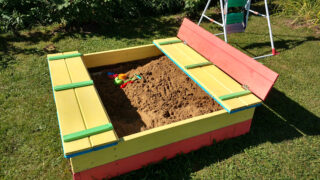
A simple sandbox is impregnated with antiseptics, water-repellent agents. Choosing environmentally friendly drug options. Treatment will prevent destruction from rain, bark beetle, mold.
Oil paints, pentaphthalic enamels are applied last, acrylic or latex compositions are used. They are applied in two layers to increase the degree of protection. From above, the painted surface is sometimes additionally varnished.
Re-coloring is carried out as the bright layer burns out and tarnishes.
Do I need a cover
Street animals spoil the sand with excrement, so you have to change it often. A lid is placed on the sandbox to avoid such a procedure. The coating will help during the period of leaf fall.
The structure must be strong to support the weight of the child if he climbs onto it and decides to jump. Handles are mounted on the lid, sometimes a bolt or lock is provided.
The lid can be completely removable, opening on hinges, transforming into a bench or two.








